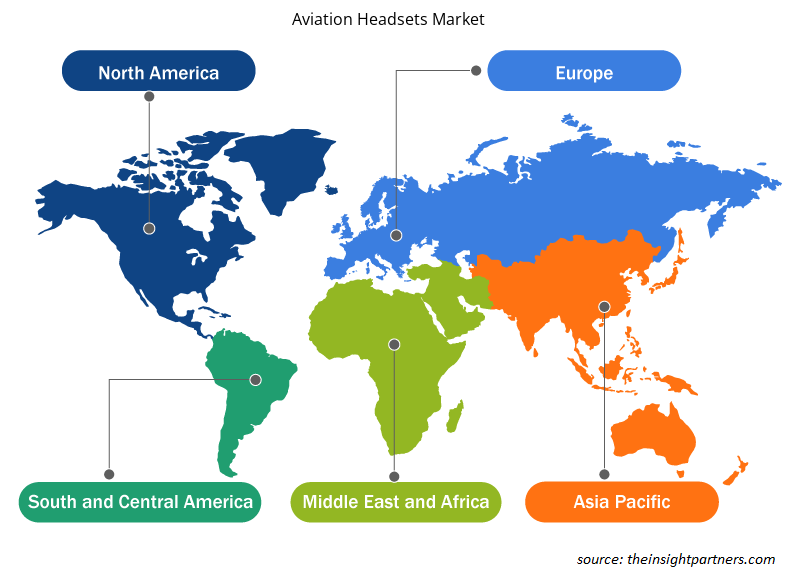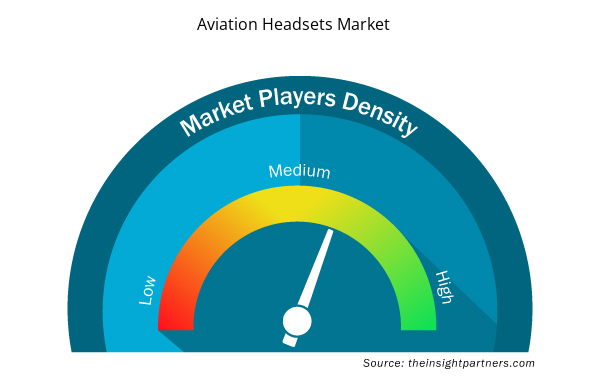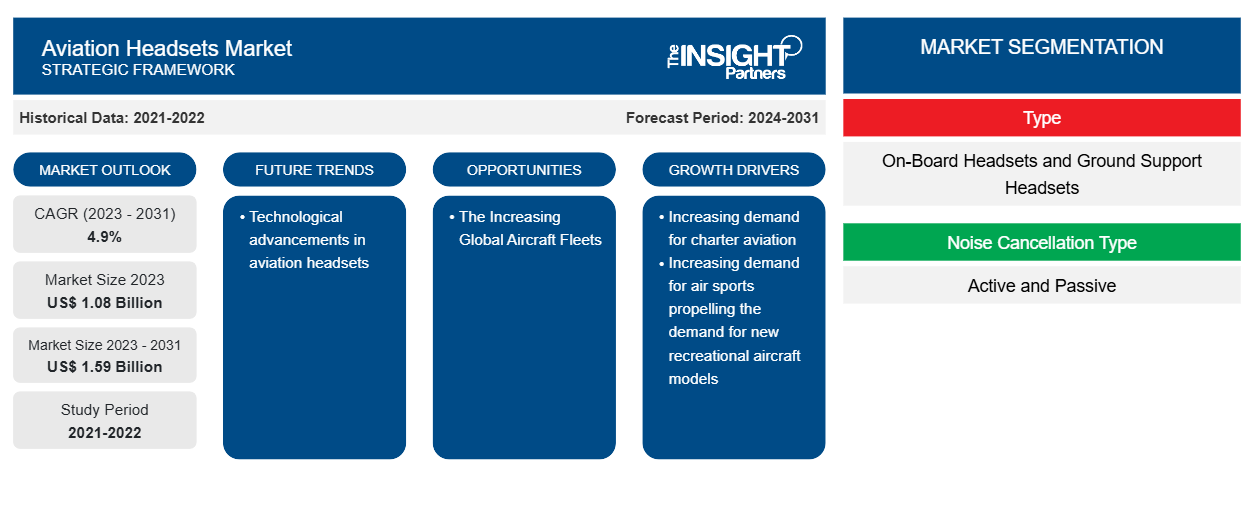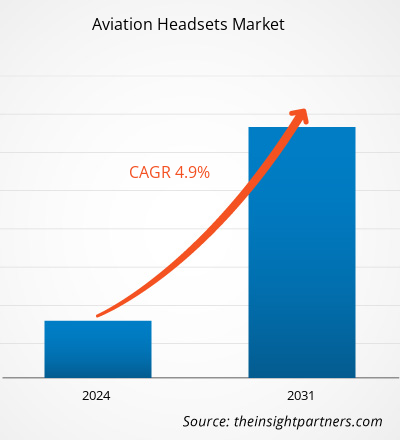Si prevede che il mercato delle cuffie per l'aviazione raggiungerà 1,59 miliardi di dollari entro il 2031, passando da 1,08 miliardi di dollari nel 2023. Si prevede che il mercato registrerà un CAGR del 4,9% nel periodo 2023-2031. È probabile che i progressi tecnologici nelle cuffie per l'aviazione rimangano una tendenza chiave nel mercato.
Analisi del mercato delle cuffie aeronautiche
L'ecosistema del mercato delle cuffie per l'aviazione è diversificato e in continua evoluzione. I suoi stakeholder sono fornitori di componenti, produttori di cuffie, distributori e utenti finali. I principali attori occupano posizioni nei vari nodi dell'ecosistema di mercato. I fornitori di componenti forniscono diversi componenti come prodotti semiconduttori/chipset, microfoni, componenti per altoparlanti ai produttori di cuffie per l'aviazione che poi li utilizzano per produrre e progettare i prodotti finali per cuffie per l'aviazione. Il prodotto finale viene poi distribuito agli utenti finali tramite diversi mezzi come le vendite dirette tramite distributori aziendali nel settore dell'aviazione.
Panoramica del mercato delle cuffie aeronautiche
Aziende come Bosch Security & Safety Systems, Bose Corporation, David Clark Company, Lightspeed Aviation, GBH Headsets, Pilot Communications, Plantronics Inc., SEHT Limited e Sennheiser Electronic GmbH & Co. Kg sono tra i principali produttori nel mercato delle cuffie per l'aviazione. Queste aziende sono impegnate nella progettazione, produzione e vendita di un'ampia gamma di cuffie per aeromobili a utenti finali come compagnie aeree, aziende MRO, OEM aeronautici e forze di difesa rispettivamente.
Personalizza questo report in base alle tue esigenze
Riceverai la personalizzazione gratuita di qualsiasi report, comprese parti di questo report, o analisi a livello nazionale, pacchetto dati Excel, oltre a usufruire di grandi offerte e sconti per start-up e università
- Scopri le principali tendenze di mercato in questo rapporto.Questo campione GRATUITO includerà analisi di dati che spaziano dalle tendenze di mercato alle stime e alle previsioni.
Driver e opportunità del mercato delle cuffie aeronautiche
La crescente domanda di sport aerei spinge la domanda di nuovi modelli di aerei ricreativi
Il crescente numero di consegne di velivoli sportivi leggeri dovuto a una maggiore consapevolezza degli sport aerei tra i giovani in tutto il mondo sta aiutando l'implementazione di modelli di velivoli ricreativi di nuova generazione. Ad esempio, la crescente flotta di LSA (velivoli sportivi leggeri) esistenti sta generando la domanda di nuovi piloti e accessori per cuffie in tutto il mondo. Inoltre, la domanda di LSA è principalmente guidata dal crescente interesse per attività ricreative come il paracadutismo e sta aprendo la strada a nuovi operatori per stabilire attività commerciali mentre gli operatori esistenti espandono la loro attività creando una nuova base e acquistando nuovi velivoli. Pertanto, la crescente flotta di velivoli sportivi leggeri in tutto il mondo sta aiutando l'adozione di cuffie per l'aviazione a livello globale.
L'aumento delle flotte di aeromobili globali
Secondo la ricerca secondaria di The Insight Partners, la flotta globale di aeromobili commerciali nel 2022 era di circa 25.578 aeromobili, che probabilmente raggiungerà circa 28.398 aeromobili entro la fine del 2024 e circa 36.413 aeromobili entro la fine del 2034. Inoltre, secondo le previsioni divulgate da due dei principali OEM di aeromobili, ovvero Boeing e Airbus, si prevede che saranno consegnati oltre 40.800 aeromobili entro la fine del 2042, il che genererà ulteriormente la domanda di nuovi piloti e cuffie nei prossimi anni.
Analisi della segmentazione del rapporto di mercato delle cuffie aeronautiche
I segmenti chiave che hanno contribuito alla derivazione dell'analisi di mercato delle cuffie aeronautiche sono il tipo di cancellazione del rumore e l'applicazione.
- In base al tipo, il mercato delle cuffie aeronautiche è segmentato in cuffie di bordo e cuffie di supporto a terra. Il segmento delle cuffie di bordo ha detenuto una quota di mercato maggiore nel 2023.
- In base al tipo di cancellazione del rumore, il mercato delle cuffie aeronautiche è segmentato in attivo e passivo. Il segmento attivo ha detenuto una quota di mercato maggiore nel 2023.
- In base all'applicazione, il mercato delle cuffie per l'aviazione è segmentato in aeromobili commerciali, aeromobili militari e aviazione generale. Il segmento commerciale ha detenuto una quota di mercato maggiore nel 2023.
Analisi della quota di mercato delle cuffie aeronautiche per area geografica
L'ambito geografico del rapporto sul mercato delle cuffie per l'aviazione è suddiviso principalmente in cinque regioni: Nord America, Europa, Asia Pacifico, Medio Oriente e Africa e Sud America.
Il Nord America ha dominato il mercato nel 2023, seguito dall'Europa e dalle regioni dell'Asia Pacifica. Inoltre, è probabile che anche l'Asia Pacifica assista al CAGR più elevato nei prossimi anni. Ciò è dovuto principalmente alle consegne previste di oltre 18.800 nuovi aeromobili commerciali in tutta la regione nei prossimi due decenni. Inoltre, il crescente numero di aeroporti nella regione dell'Asia Pacifica sta anche spingendo l'impiego di un numero maggiore di aeroplani nella regione, il che è ulteriormente probabile che generi nuove opportunità per i venditori di mercato nei prossimi anni.
Approfondimenti regionali sul mercato delle cuffie aeronautiche
Le tendenze regionali e i fattori che influenzano il mercato delle cuffie aeronautiche durante il periodo di previsione sono stati ampiamente spiegati dagli analisti di Insight Partners. Questa sezione discute anche i segmenti e la geografia del mercato delle cuffie aeronautiche in Nord America, Europa, Asia Pacifico, Medio Oriente e Africa e America meridionale e centrale.

- Ottieni i dati specifici regionali per il mercato delle cuffie aeronautiche
Ambito del rapporto sul mercato delle cuffie per l'aviazione
| Attributo del report | Dettagli |
|---|---|
| Dimensioni del mercato nel 2023 | 1,08 miliardi di dollari USA |
| Dimensioni del mercato entro il 2031 | 1,59 miliardi di dollari USA |
| CAGR globale (2023-2031) | 4,9% |
| Dati storici | 2021-2022 |
| Periodo di previsione | 2024-2031 |
| Segmenti coperti | Per tipo
|
| Regioni e Paesi coperti | America del Nord
|
| Leader di mercato e profili aziendali chiave |
|
Densità degli attori del mercato: comprendere il suo impatto sulle dinamiche aziendali
Il mercato delle cuffie per l'aviazione sta crescendo rapidamente, spinto dalla crescente domanda degli utenti finali dovuta a fattori quali l'evoluzione delle preferenze dei consumatori, i progressi tecnologici e una maggiore consapevolezza dei vantaggi del prodotto. Con l'aumento della domanda, le aziende stanno ampliando le loro offerte, innovando per soddisfare le esigenze dei consumatori e capitalizzando sulle tendenze emergenti, il che alimenta ulteriormente la crescita del mercato.
La densità degli operatori di mercato si riferisce alla distribuzione di aziende o società che operano in un particolare mercato o settore. Indica quanti concorrenti (operatori di mercato) sono presenti in un dato spazio di mercato in relazione alle sue dimensioni o al valore di mercato totale.
Le principali aziende che operano nel mercato delle cuffie per l'aviazione sono:
- Sistemi di sicurezza e protezione Bosch
- Società Bose
- Azienda David Clark
- Faro Aviazione
- Cuffie GBH
Disclaimer : le aziende elencate sopra non sono classificate secondo un ordine particolare.

- Ottieni una panoramica dei principali attori del mercato delle cuffie aeronautiche
Notizie e sviluppi recenti sul mercato delle cuffie aeronautiche
Il mercato delle cuffie per l'aviazione viene valutato raccogliendo dati qualitativi e quantitativi dopo la ricerca primaria e secondaria, che include importanti pubblicazioni aziendali, dati associativi e database. Di seguito sono elencati alcuni degli sviluppi nel mercato delle cuffie per l'aviazione:
- Bose, leader nella tecnologia delle cuffie aeronautiche premium, ha annunciato oggi la sua ultima innovazione: la nuova cuffia aeronautica A30. Presentata al SUN 'n FUN Aerospace Expo di Lakeland, Florida, la A30 è un prodotto completamente nuovo, progettato per offrire ai piloti la migliore combinazione di comfort, cancellazione del rumore e chiarezza audio di qualsiasi cuffia aeronautica sul mercato. (Fonte: Bose, comunicato stampa, marzo 2023)
Lightspeed Aviation ha presentato oggi Lightspeed Delta Zulu, il primo modello della prossima generazione di cuffie ANR. Questa rivoluzionaria cuffia ANR per l'aviazione introduce una serie di nuove funzionalità e annuncia una nuova categoria di prodotti per l'aviazione denominata "Safety Wearables". (Fonte: Lightspeed Aviation, comunicato stampa, settembre 2022)
Copertura e risultati del rapporto sul mercato delle cuffie per l'aviazione
Il rapporto "Dimensioni e previsioni del mercato delle cuffie per l'aviazione (2021-2031)" fornisce un'analisi dettagliata del mercato che copre le seguenti aree:
- Dimensioni e previsioni del mercato delle cuffie per l'aviazione a livello globale, regionale e nazionale per tutti i principali segmenti di mercato coperti dall'ambito
- Tendenze del mercato delle cuffie per l'aviazione e dinamiche di mercato come driver, restrizioni e opportunità chiave
- Analisi dettagliata delle cinque forze di Porter
- Analisi del mercato delle cuffie per l'aviazione che copre le principali tendenze del mercato, il quadro globale e regionale, i principali attori, le normative e i recenti sviluppi del mercato
- Analisi del panorama industriale e della concorrenza che copre la concentrazione del mercato, l'analisi della mappa di calore, i principali attori e gli sviluppi recenti per il mercato delle cuffie aeronautiche
- Profili aziendali dettagliati
- Analisi storica (2 anni), anno base, previsione (7 anni) con CAGR
- Analisi PEST e SWOT
- Valore/volume delle dimensioni del mercato - Globale, regionale, nazionale
- Industria e panorama competitivo
- Set di dati Excel



Report Coverage
Revenue forecast, Company Analysis, Industry landscape, Growth factors, and Trends

Segment Covered
This text is related
to segments covered.

Regional Scope
North America, Europe, Asia Pacific, Middle East & Africa, South & Central America

Country Scope
This text is related
to country scope.
Domande frequenti
North America region dominated the aviation headsets market in 2023.
Increasing demand for charter aviation and increasing demand for air sports propelling the demand for new recreational aircraft models are some of the factors driving the growth for aviation headsets market.
Technological advancements in aviation headsets in airfield ground lighting solutions is one of the major trends of the market.
Bosch Security and Safety Systems, Bose Corporation, David Clark Company, Faro Aviation, GBH Headsets, Lightspeed Aviation, Pilot Communications, Plantronics Inc, SEHT LIMITED, Sennheiser Electronic GmbH and Co KG, MicroAvionics, Aerotion Aviation, and Radial Avcomm LLC are some of the key players profiled under the report.
The estimated value of the aviation headsets market by 2031 would be around US$ 1.59 billion.
The aviation headsets market is likely to register of 4.9% during 2023-2031.
Trends and growth analysis reports related to Aerospace and Defense : READ MORE..
The Insight Partners performs research in 4 major stages: Data Collection & Secondary Research, Primary Research, Data Analysis and Data Triangulation & Final Review.
- Data Collection and Secondary Research:
As a market research and consulting firm operating from a decade, we have published and advised several client across the globe. First step for any study will start with an assessment of currently available data and insights from existing reports. Further, historical and current market information is collected from Investor Presentations, Annual Reports, SEC Filings, etc., and other information related to company’s performance and market positioning are gathered from Paid Databases (Factiva, Hoovers, and Reuters) and various other publications available in public domain.
Several associations trade associates, technical forums, institutes, societies and organization are accessed to gain technical as well as market related insights through their publications such as research papers, blogs and press releases related to the studies are referred to get cues about the market. Further, white papers, journals, magazines, and other news articles published in last 3 years are scrutinized and analyzed to understand the current market trends.
- Primary Research:
The primarily interview analysis comprise of data obtained from industry participants interview and answers to survey questions gathered by in-house primary team.
For primary research, interviews are conducted with industry experts/CEOs/Marketing Managers/VPs/Subject Matter Experts from both demand and supply side to get a 360-degree view of the market. The primary team conducts several interviews based on the complexity of the markets to understand the various market trends and dynamics which makes research more credible and precise.
A typical research interview fulfils the following functions:
- Provides first-hand information on the market size, market trends, growth trends, competitive landscape, and outlook
- Validates and strengthens in-house secondary research findings
- Develops the analysis team’s expertise and market understanding
Primary research involves email interactions and telephone interviews for each market, category, segment, and sub-segment across geographies. The participants who typically take part in such a process include, but are not limited to:
- Industry participants: VPs, business development managers, market intelligence managers and national sales managers
- Outside experts: Valuation experts, research analysts and key opinion leaders specializing in the electronics and semiconductor industry.
Below is the breakup of our primary respondents by company, designation, and region:

Once we receive the confirmation from primary research sources or primary respondents, we finalize the base year market estimation and forecast the data as per the macroeconomic and microeconomic factors assessed during data collection.
- Data Analysis:
Once data is validated through both secondary as well as primary respondents, we finalize the market estimations by hypothesis formulation and factor analysis at regional and country level.
- Macro-Economic Factor Analysis:
We analyse macroeconomic indicators such the gross domestic product (GDP), increase in the demand for goods and services across industries, technological advancement, regional economic growth, governmental policies, the influence of COVID-19, PEST analysis, and other aspects. This analysis aids in setting benchmarks for various nations/regions and approximating market splits. Additionally, the general trend of the aforementioned components aid in determining the market's development possibilities.
- Country Level Data:
Various factors that are especially aligned to the country are taken into account to determine the market size for a certain area and country, including the presence of vendors, such as headquarters and offices, the country's GDP, demand patterns, and industry growth. To comprehend the market dynamics for the nation, a number of growth variables, inhibitors, application areas, and current market trends are researched. The aforementioned elements aid in determining the country's overall market's growth potential.
- Company Profile:
The “Table of Contents” is formulated by listing and analyzing more than 25 - 30 companies operating in the market ecosystem across geographies. However, we profile only 10 companies as a standard practice in our syndicate reports. These 10 companies comprise leading, emerging, and regional players. Nonetheless, our analysis is not restricted to the 10 listed companies, we also analyze other companies present in the market to develop a holistic view and understand the prevailing trends. The “Company Profiles” section in the report covers key facts, business description, products & services, financial information, SWOT analysis, and key developments. The financial information presented is extracted from the annual reports and official documents of the publicly listed companies. Upon collecting the information for the sections of respective companies, we verify them via various primary sources and then compile the data in respective company profiles. The company level information helps us in deriving the base number as well as in forecasting the market size.
- Developing Base Number:
Aggregation of sales statistics (2020-2022) and macro-economic factor, and other secondary and primary research insights are utilized to arrive at base number and related market shares for 2022. The data gaps are identified in this step and relevant market data is analyzed, collected from paid primary interviews or databases. On finalizing the base year market size, forecasts are developed on the basis of macro-economic, industry and market growth factors and company level analysis.
- Data Triangulation and Final Review:
The market findings and base year market size calculations are validated from supply as well as demand side. Demand side validations are based on macro-economic factor analysis and benchmarks for respective regions and countries. In case of supply side validations, revenues of major companies are estimated (in case not available) based on industry benchmark, approximate number of employees, product portfolio, and primary interviews revenues are gathered. Further revenue from target product/service segment is assessed to avoid overshooting of market statistics. In case of heavy deviations between supply and demand side values, all thes steps are repeated to achieve synchronization.
We follow an iterative model, wherein we share our research findings with Subject Matter Experts (SME’s) and Key Opinion Leaders (KOLs) until consensus view of the market is not formulated – this model negates any drastic deviation in the opinions of experts. Only validated and universally acceptable research findings are quoted in our reports.
We have important check points that we use to validate our research findings – which we call – data triangulation, where we validate the information, we generate from secondary sources with primary interviews and then we re-validate with our internal data bases and Subject matter experts. This comprehensive model enables us to deliver high quality, reliable data in shortest possible time.


 Ottieni un campione gratuito per questo repot
Ottieni un campione gratuito per questo repot